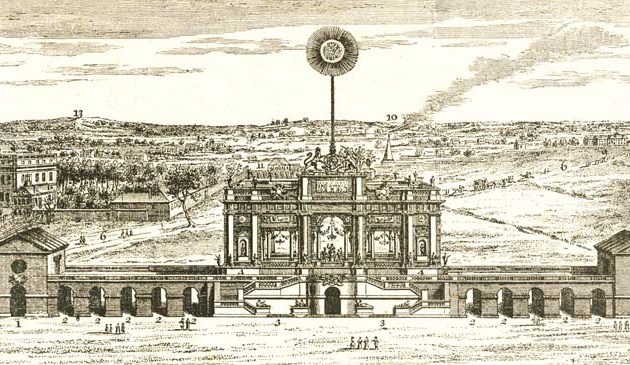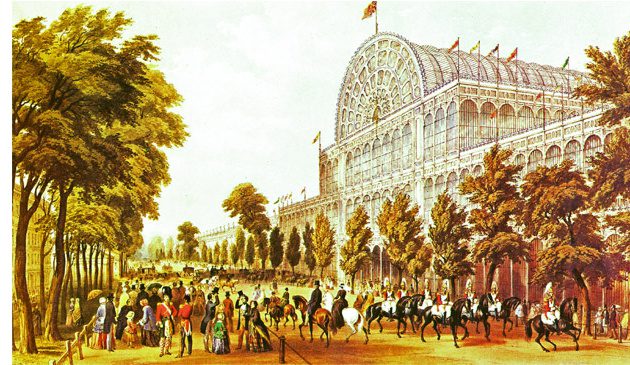Whitehall Palace in the Stuart period

The Holbein Gate of the former Whitehall Palace, with the Banqueting House on the right, as they were in 1743 It is from a drawing by Thomas Sandby, who was employed as a draughtsman at the Tower of London. The gate was removed in 1759 and much of the material acquired by the Duke of Cumberland to be installed at Windsor Great Park under Sandby’s direction.
Christopher Wren had started work on new apartments for James and his wife Mary of Modena but they were completed long after their flight to France. William, however, suffered from asthma and found Whitehall’s riverside location uncongenial. In the summer of 1689 the new royal couple purchased Nottingham House at Kensington, three miles to the west on the far side of Hyde Park. In the following years they converted it into their new home and other members of the royal court began moving to that area.
Whitehall ceased to be the royal residence when the royal couple established Kensington Palace, although for several years it continued to be where much state business continued to take place. Nevertheless, further improvements were undertaken at Whitehall. A terrace garden for Mary was started in 1691, involving the demolition of the Privy Stairs that projected into the river. (Part of the terrace remains at the rear of the Ministry of Defence).
Fire was an ever-present danger at Whitehall, with its various buildings and residential apartments. In April 1691 a blaze began at eight o’clock in the evening in the former apartment of the Duchess of Portsmouth. It was only extinguished at four in the morning, destroying everything between the Stone Gallery and the river.
Mary died of smallpox at Kensington Palace in December 1694. Her body was taken to Banqueting House for it to be seen by the public. The funeral took place at Westminster Abbey at the beginning of March.
On 4th January 1698 another fire began at about four in the afternoon in the King’s apartments, eventually lasting seventeen hours and spreading throughout the palace. It was said to have been started when a Dutch maid left some linen to dry beside a charcoal fire. Sir Christopher Wren was then living in one of the apartments and he and Lord Cutts, commander of the troops, helped tackle the blaze. About 150 buildings of the palace complex, many being the residences of the royal family and nobility, were destroyed, although the Banqueting House and Scotland Yard were spared. Most of the paintings, tapestries and furniture were saved but a dozen people perished, including the maid. John Evelyn noted in his diary: “Whitehall burnt utterly to the ground, nothing but the walls and ruines left”. Henry VIII’s Holbein Gate survived but was taken down when the street was widened in 1759 and the stones and busts dispersed elsewhere.
One other survivor of the fire was Henry VIII’s wine cellar, now located beneath the Ministry of Defence. The depth of the new building would have involved the destruction of the cellar if it wasn’t for the intervention of Queen Mary, widow of King George V. Instead, in 1949 it was encased in steel and concrete and moved about three metres to the west and six metres lower.
Christopher Wren produced plans for a new palace incorporating the Banqueting House but it never proceeded, probably because of the expense. The King was anyway living at Kensington Palace, and the official business of the royal court moved from Whitehall to St. James’s Palace. Banqueting House was fitted out as a Chapel Royal, including a new organ and pulpit, and was ready for Christmas 1698.
Much of the area lay empty for a generation. Plots of land were leased to members of the nobility, who built new town houses for themselves on the site of the former palace. Fifty years later the Horse Guards and courtyard was built according to the design of William Kent and completed in 1748.
Over time the once vast Whitehall Palace has largely been forgotten. Despite the hopes of several monarchs, particularly James I and Charles II, at the time of its destruction little progress had been made to transform Whitehall into a truly magnificent palace that would rival Versailles. A Frenchman who had visited in 1665 reported the palace as “ill built, and nothing but a heap of houses erected at divers times, and of different Models”. In reality it had changed little during the 160 years since the time of Henry VIII, with Banqueting House being the main exception.
Sources include: Susan Foreman ‘From Palace to Power’; Edgar Sheppard ‘The Old Royal Palace of Whitehall’ (1902); Simon Thurley ‘The Whitehall Palace Plan of 1670’ (London Topographical Society); Lisa Jardine ‘On a Grander Scale’; Edward Walford ‘Old & New London’ (1897); Robin Rowles ‘The Civil War in London’.
< Back to The Tudor Whitehall Palace


